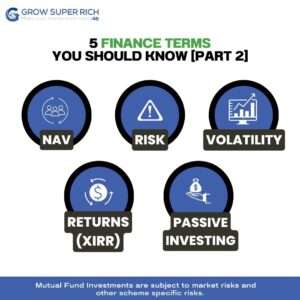1. Start with a clear investment goal
When building a mutual fund portfolio, it’s crucial to begin by defining your investment goals. Determine what you want to achieve with your portfolio—is it long-term growth, generating regular income, or a mix of both? Having a clear objective will guide your investment decisions and help you stay focused throughout your investment journey.
For example, if your goal is long-term growth, you might consider equity-focused mutual funds that have historically delivered higher returns over an extended period. On the other hand, if your primary objective is generating income, you might opt for debt or fixed-income mutual funds that provide regular interest payments.
2. Consider risk vs. return
Finding the right balance between risk and return is essential for a well-rounded portfolio. Mutual funds offer a range of options with varying risk profiles. Evaluate different mutual funds and strike a balance between high-risk, high-reward funds and more stable, lower-risk options.
High-risk funds, such as equity funds, have the potential for significant returns but also come with increased volatility. Lower-risk funds, such as debt funds, provide more stability but with lower potential returns. By combining both types of funds, you can optimize your returns while managing potential volatility.
Consider your risk tolerance, which is your ability to withstand fluctuations in the value of your investments. If you have a higher risk tolerance and a longer investment horizon, you may be comfortable allocating a larger portion of your portfolio to high-risk funds. However, if you have a lower risk tolerance or a shorter investment horizon, a higher allocation to lower-risk funds might be more suitable for you. Asset Allocation is the core decision of any balanced portfolio. Get that right!
3. Research, research, research
Thoroughly researching different mutual funds is crucial to make informed investment decisions. Look beyond the fund’s past performance and consider factors such as the fund manager’s experience, the fund’s investment philosophy, and its track record during various market cycles.
Dig deep into the fund’s prospectus, which provides detailed information about its investment objectives, holdings, expenses, and risks. Look for funds that align with your investment goals, risk tolerance, and time horizon. Consider a mix of asset classes, including equity, debt, and hybrid funds, to diversify your portfolio effectively.
It’s also important to consider the fund’s historical performance relative to its benchmark and peers. A fund that consistently outperforms its benchmark and peers may indicate skilled fund management.
4. Diversify like a pro
Diversification is a fundamental principle in building a balanced mutual fund portfolio. It involves spreading your investments across various asset classes, sectors, and geographical regions to reduce the impact of any single investment’s performance on your overall portfolio.
By diversifying, you can potentially mitigate the risks associated with any particular asset class or sector. For example, if you invest solely in technology stocks and the technology sector experiences a downturn, your portfolio would be significantly impacted. However, by including mutual funds from different sectors like healthcare, finance, and consumer goods, you can reduce the impact of sector-specific risks.
Mutual funds provide an excellent way to diversify your investments across sectors and asset classes. Many mutual funds offer diversification within a single fund by investing in a portfolio of stocks or bonds from different companies or issuers. By investing in a mix of mutual funds that span different asset classes and sectors, you can achieve effective diversification.
5. Keep an eye on expenses
When selecting mutual funds for your portfolio, it’s essential to consider the expenses associated with each fund. These expenses can have a significant impact on your overall returns over time.
One crucial metric to evaluate is the expense ratio, which represents the annual fees charged by the fund for managing your investments. Look for funds with low expense ratios, as these funds tend to have a more favourable impact on your returns.
It’s worth noting that actively managed funds typically have higher expense ratios compared to passively managed funds, such as index funds or exchange-traded funds (ETFs). Actively managed funds involve higher research and management costs, which are reflected in their expense ratios. However, they also aim to outperform their benchmarks through active investment strategies.
Consider whether the potential benefits of an actively managed fund justify the higher expenses or if a low-cost passively managed fund might be a more suitable option for certain asset classes. Balancing expenses with potential returns is crucial in building a cost-effective portfolio.
6. Monitor and rebalance
Building a well-rounded mutual fund portfolio requires ongoing monitoring and periodic rebalancing. Review your portfolio regularly to ensure it remains aligned with your investment goals and risk tolerance.
Market conditions and individual fund performance can cause your portfolio to deviate from its original asset allocation. To maintain the desired balance, periodically rebalance your portfolio by buying or selling funds to realign your holdings with your target allocation.
Rebalancing allows you to take profits from outperforming funds and reinvest them in underperforming funds. This strategy helps you maintain the intended risk-reward profile of your portfolio and adapt to changing market conditions.
It’s important to note that rebalancing should not be based solely on short-term market movements but should be driven by a long-term perspective and the desire to maintain a well-diversified portfolio.
Conclusion
In conclusion, building a well-rounded mutual fund portfolio requires thorough research, effective diversification, and careful monitoring. By setting clear investment goals, striking a balance between risk and return, conducting extensive research, diversifying across asset classes, considering expenses, and monitoring and rebalancing your portfolio, you can increase the likelihood of achieving your financial objectives.
Start building your balanced mutual fund portfolio today and embark on your journey toward financial success!
Disclaimer:
The information provided in this article is for educational purposes only and should not be considered as financial advice.
It is always recommended to consult with a qualified financial advisor before making any investment decisions.




